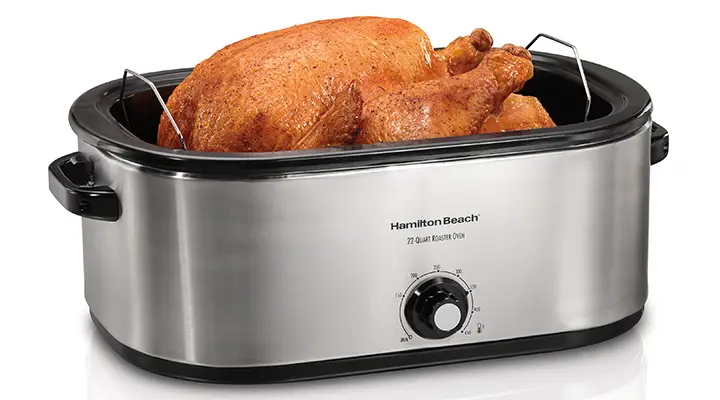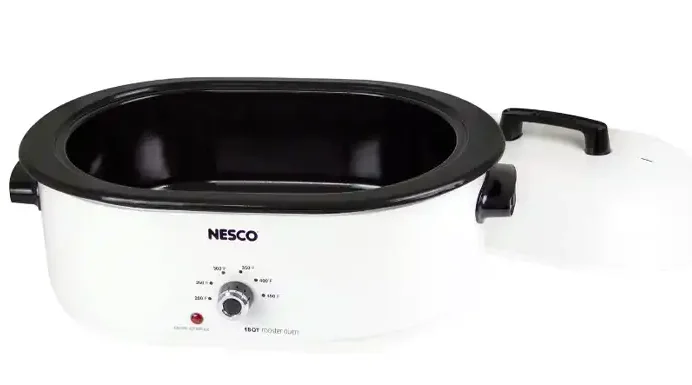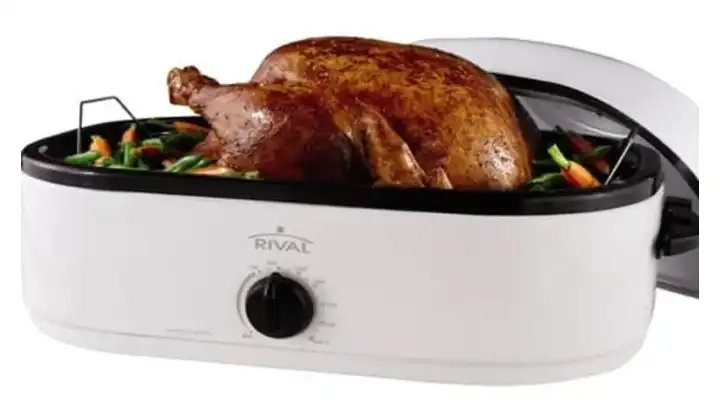Do You Put Water in the Bottom of a Roaster Oven? To Water or Not to Water
Roaster ovens, renowned for their versatility in slow cooking, baking, and deep-frying, are essential kitchen appliances. Generally, water is not needed in the bottom of a roaster oven, as these devices efficiently trap and recycle natural cooking moisture. However, understanding water usage nuances is key. In brief, the answer is no, but exceptions exist.
This article delves into the intricacies, exploring when water is necessary, its purpose, and exceptions to the rule. By the end, you’ll grasp the significance of water in roaster ovens, ensuring your culinary adventures result in perfectly cooked, flavorful dishes.

What is The Purpose of Water in the Bottom of a Roaster Oven?
The purpose of water in a roaster oven goes beyond a simple yes or no answer. While it’s generally unnecessary, there are instances where water serves a specific function, contributing to a conducive cooking environment and enhancing the overall culinary experience.
Creating a Conducive Cooking Environment:
The primary function of water in a roaster oven is to create an optimal cooking environment. For certain recipes or cooking methods, introducing water can elevate the humidity within the oven. This steamy atmosphere is particularly beneficial for preventing specific foods, such as seafood, from drying out during the cooking process. The controlled introduction of moisture helps maintain tenderness and juiciness, ensuring that delicate items are cooked to perfection.
Impact on Flavors and the Overall Cooking Process:
Flavor Enhancement: Contrary to a common misconception, adding water does not necessarily enhance flavors. The natural juices released by the cooking ingredients contribute significantly to the overall taste. The roaster oven’s ability to retain and recycle these juices eliminates the need for additional water, preserving the authentic and robust flavors of the dish.
Moisture Regulation: Water plays a role in regulating the moisture content during cooking. While excessive moisture can lead to bland and soggy results, controlled use of water becomes crucial when dealing with lean cuts of meat. Adding a small amount of water in such cases helps prevent the meat from drying out excessively without compromising texture.
Steam and Even Cooking: The introduction of steam through water can aid in achieving more even cooking, especially in recipes where maintaining moisture levels is critical. This is particularly relevant for dishes requiring precise temperature control and a humid environment.
In essence, the purpose of water in a roaster oven is nuanced. It’s about carefully considering the specific requirements of each dish and adapting the cooking environment accordingly. While the default is often a moisture-rich setting, recognizing when and how to use water ensures that the roaster oven becomes a versatile tool for creating a wide array of delicious and perfectly cooked meals.
Water Level and Its Significance
Addressing the query of whether to put water in the bottom of a roaster brings us to an exploration of water levels and their significance. Understanding the delicate balance between water, steam, and various cooking scenarios is pivotal for optimal results in a roaster oven.
Do I Put Water in the Bottom of My Roaster Oven?
The general advice is no; you don’t typically need to put water in the bottom of a roaster. However, the need for water can vary based on factors like the type of food being cooked, the desired outcome, and the specific recipe instructions. Let’s delve into the significance of water levels in different culinary contexts.
Examining the Relationship Between Water Level and Steam:
Steam and Moisture Control: Water in the bottom of a roaster oven can contribute to steam production, influencing the moisture levels within the cooking space. For recipes that benefit from a steamier environment, such as certain bread or seafood preparations, a controlled addition of water may be recommended.
Lean Cuts of Meat: The relationship between water level and lean cuts of meat is crucial. While roaster ovens are adept at retaining natural juices, very lean meats might benefit from a small amount of added water to prevent excessive drying during cooking. It’s a delicate balance, as too much water can lead to undesirable results.
Temperature Regulation: Water levels can also play a role in temperature regulation. The introduction of steam can help moderate the overall temperature within the roaster oven, ensuring a consistent and controlled cooking environment.
Recipe-Specific Considerations: Some recipes may explicitly call for water in the bottom of the roaster oven to achieve specific culinary outcomes. This is particularly common in baking, where the presence of steam can influence the texture and crust of the final product.
In essence, the significance of water levels in a roaster oven lies in their ability to influence the cooking environment. While the default is often to operate without additional water, recognizing when and how to incorporate it is key to adapting the roaster oven to the unique requirements of diverse recipes and cooking methods.
Roaster Oven Brands and Water Usage
When it comes to roaster ovens, understanding the nuances of water usage can vary from one brand to another. Let’s explore the water requirements for popular roaster oven brands—Oster, Nesco, Hamilton Beach, Rival, and more—unveiling specific insights into each brand’s recommendations.
Oster:
Water Usage Overview: Oster roaster ovens generally follow the industry trend—no additional water is required for most cooking scenarios. The design focuses on retaining and recycling natural cooking moisture. However, exceptions may apply, and it’s advised to consult specific Oster recipe instructions for any water-related requirements.
Nesco:
Water Usage Overview: Nesco roaster ovens, much like their counterparts, are crafted to operate efficiently without the need for extra water. The appliance’s design prioritizes moisture retention. Users are encouraged to follow Nesco’s recipe guidelines for any instances where water might be recommended, especially in recipes where a steamier environment is desired.

Hamilton Beach:
Water Usage Overview: Hamilton Beach roaster ovens align with the standard practice of not requiring water in the bottom for most cooking scenarios. The self-basting lids in some models enhance moisture retention. Users are advised to refer to Hamilton Beach’s specific guidelines for water usage, especially if following unique recipes or cooking methods.
Rival:
Water Usage Overview: Rival roaster ovens, in line with industry norms, typically do not need additional water. The emphasis is on utilizing the natural juices produced during cooking. Rival’s user manuals and recipe instructions provide valuable insights into any exceptions where water might be recommended for specific dishes or desired outcomes.

Other Brands (Proctor Silex, Cuisinart, KitchenAid, Ronco, Bella, Sunbeam):
Water Usage Overview: These roaster oven brands generally follow the industry standard of not requiring water in the bottom for most cooking scenarios. Each brand may have unique features, so it’s recommended to refer to their respective user manuals and recipe instructions for any specific water-related guidelines.
Pros and Cons of Using Water in the Bottom of a Roaster Oven Based on Different Brands
Here’s a table summarizing the pros and cons of using water in different Roaster ovens:
| Roaster Oven Brand | Uses Water in the Bottom | Pros of Using Water | Cons of Using Water |
| Oster | Typically No | – Versatility in water usage for steamier environments. | – Default operation without water may be sufficient. |
| – Enhanced moisture for specific recipes. | – Risk of overly moist conditions and potential sogginess. | ||
| Nesco | Typically No | – Benefits from added water in recipes requiring a steamy setting. | – Typically operates without water, following recipe instructions is key. |
| – Contributes to moisture control. | – Overuse may result in overly humid conditions. | ||
| Hamilton Beach | Depends on Model | – Enhances steam production in certain models. | – In many cases, water may not be universally necessary. |
| – Adjustable moisture levels based on the desired outcome. | – Excessive water may dilute flavors, leading to potential blandness. | ||
| Rival | Typically No | – A small amount of water can benefit very lean cuts of meat. | – Standard operation often doesn’t require additional water. |
| – Excessive water may compromise texture, leading to toughness. | |||
| Other Brands | Depends on Model/ Typically No | – Offers adaptability in water usage for specific recipes. | – Standard operation may not necessitate additional water. |
| – Contributes to moisture retention for enhanced cooking. | – Potential texture issues with excessive water usage. |
This updated table provides information on whether each brand typically uses water in the bottom of the roaster oven, in addition to the pros and cons of using water for cooking.
If Fire Inside Do You Put Water in the Bottom of a Roaster?
In a roasting oven, no water should be used underneath the pan. Putting water underneath the pan prevents the roaster oven from working properly. Electric roaster ovens roast food by circulating air across the whole roaster chamber. When water is poured, it condenses into steam, ruining the roaster’s purpose. As a result, the foodstuff and the tasty liquid from the meat taste dull. While most electric roasters, such as Oster and Rival, need not require water, certain roaster ovens, such as those from Hamilton Beach, do. These ovens necessitate that the user understands where to place the water.
Furthermore, the retractable roasting pan is filled with water. Five-six quarts of water could be used in the detachable roasting pan, which should be placed within the roaster body. It is not recommended to pour water straight into the oven body.
Safety Measures for Handling Electrical Fires in a Roaster Oven
Water may react with the electrical components, potentially leading to electrical shock or further damage to the appliance.
Instead, follow these steps:
Turn Off the Power: Immediately disconnect the roaster oven from the power source to cut off the electrical supply.
Do Not Open the Lid: Avoid opening the lid while the appliance is in flames. Opening the lid can introduce oxygen and escalate the fire.
Use a Fire Extinguisher: If you have a fire extinguisher rated for electrical fires, use it to suppress the flames. Aim the extinguisher at the base of the fire and follow the manufacturer’s instructions.
Evacuate the Area: If the fire persists or if you are unable to control it, evacuate the immediate area and contact emergency services for assistance.
Seek Professional Help: Once the fire is extinguished, do not attempt to use the roaster oven again until it has been inspected and repaired by a qualified professional.
Remember, safety is paramount. Never use water to extinguish an electrical fire, as it can lead to severe consequences. Always prioritize your well-being and the safety of those around you in the event of a fire in a toaster oven.
Do You Put Water Between the Pans in a Roaster?
When using a roaster oven, the question of whether to add water between the pans may arise, especially when cooking multiple items simultaneously. The decision to use water between the pans depends on the specific cooking requirements and desired outcomes.
Cooking Multiple Items:
If you’re cooking various dishes at the same time, you might consider placing water between the pans to create a steamy environment. This can be particularly beneficial for certain recipes, as the steam helps retain moisture and prevent drying out of the food.
Avoiding Direct Contact:
Placing water between the pans can also prevent direct contact between the dishes, which is crucial if you want to maintain the distinct flavors of each item. It acts as a barrier, ensuring that flavors do not intermingle during the cooking process.
Steam Cooking:
For recipes that benefit from steam cooking, adding water between the pans can be a suitable technique. This method is often employed when preparing delicate dishes that require gentle and moist cooking conditions.
Cleaning Considerations:
While adding water between the pans can have its advantages, it’s essential to be mindful of potential cleaning challenges. Steam and condensation can create a mess between the pans, making it necessary to clean thoroughly after use.
Do You Put Water in the Bottom of a Roaster to Keep Food Warm?
These rosters not only can cook food but also can keep the food warm before serving. Just follow these simple steps to keep your food warm on a roaster.
- To keep items warm, should use buffet trays with the roaster. Take out the insert pan and use two liters of warm water to fill the base. Place the roaster cover above.
- Set the thermostat to 350°F and leave it to preheat for 30 minutes. Remove the lid and reduce the heat to 200°F to keep stuff warm.
- Put the buffet tray on the platform, with the pans’ lips resting on the base’s edge. Cover the pans with the cover. When it’s time to add food, raise the cover over the pan you’ll be filling, or detach the entire cover.
User Tips and Experiences
BirdBearHareFishy, a user from Reddit of a user of roaster oven, shares valuable insights based on their experience:
I have this roaster, and one crucial tip is: DO NOT ADD WATER. The roaster oven is not designed to have water in it. Doing so can damage the appliance and pose a risk of electrocution. Similar to a crock pot, you don’t add water to the base of your roaster oven. It’s important to clarify that electronic appliances are not meant for water unless explicitly designed for it.
This user emphasizes the potential risks associated with adding water to the roaster oven, highlighting that ingredients, whether liquid or otherwise, should go into the insert. Their comparison to a crock pot further emphasizes the point that water should only be added to the base of electronic appliances if specified in the user manual. Following such user experiences ensures the safe and effective use of the roaster oven.
Another user, sharing their experience on Fixya, provides a different perspective:
If you are trying to keep things warm, like with a warmer tray, it’s perfectly fine to add water. This can also keep the food a little moister from the steam. While it’s not necessary to add water, it’s an option you can consider. Keep in mind that water may leave a deposit line inside the unit as it evaporates during heating. This, however, won’t harm anything and can be easily cleaned with some cleaner and a scrubber.
On the other hand, if you’re using the roaster oven for cooking, it’s advised not to use water. Simply place the food in the insert and cook it as is. This user experience suggests that the decision to use water depends on the purpose—keeping warm or cooking. In the case of keeping warm, water can add moisture, but for cooking, it’s generally recommended to skip the water and cook directly in the insert.
Below, I provide some commonly asked questions that you may also have on your mind:-
Do You Put Water in the Bottom of the Roasting Pan for Turkey?
In a roasting pan, it’s generally not necessary to add water when cooking a turkey. Roaster ovens are designed to trap and recycle the natural juices released during cooking, creating a humid environment that promotes even cooking and prevents drying. Adding water to the roasting pan may compromise the desired crispiness of the turkey skin.
Do You Put Water in the Bottom of a Crock Pot?
No, adding water to the bottom of a slow cooker or crock pot is usually not required. Slow cookers are designed to cook food slowly at low temperatures, and they retain moisture well. The lid of the crock pot helps trap steam, creating a self-basting environment that keeps the food moist during the cooking process.
Do You Put Water in the Bottom of an Electric Roaster?
In most cases, no. Electric roasters are designed to operate without the need for additional water. They utilize the natural juices from the cooking ingredients to create a moist cooking environment. However, certain recipes or cooking methods may call for specific water additions, so it’s essential to follow recipe instructions.
Do You Put Water in the Bottom of a Slow Cooker?
Generally, there’s no need to add water to the bottom of a slow cooker. Slow cookers are designed to retain moisture, and the lid helps trap steam, creating a self-basting environment. Adding water might dilute the natural flavors and result in a less flavorful dish.
Do You Put Water in the Bottom of a Crock Pot for Meatloaf?
It’s not necessary to add water to the bottom of a slow cooker when making meatloaf. The slow cooker’s design promotes moisture retention, and the meatloaf will release its juices during cooking, creating a flavorful and moist dish.
Do You Put Water in the Bottom of a Convection Oven?
No, water is generally not needed in the bottom of a convection oven. Convection ovens use a fan to circulate hot air, creating an evenly heated cooking environment. Adding water is unnecessary and may interfere with the convection process.
Ending Thoughts
Roaster ovens are no different from regular ovens in terms of cooking. However, the Roaster oven doesn’t require water at the bottom of it. It’s better to not use any water whats so ever unless it is for the recipe itself.
Most Roaster ovens don’t need any water to operate on the other hand some oven does need water to operate. The steam from water can mess up the whole cooking and can destroy the flavor. So, when unnecessary it’s better to avoid using any water whatsoever to avoid any unwanted outcome.
If you have any confusion about your oven, do not hesitate to ask in the comment box below. We would love to hear from you.






